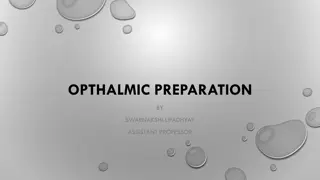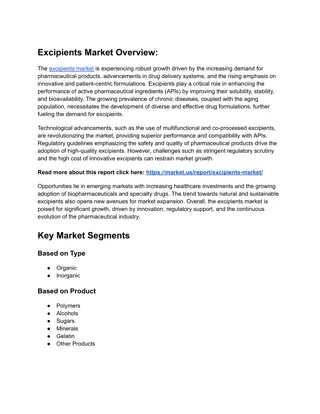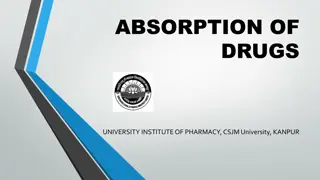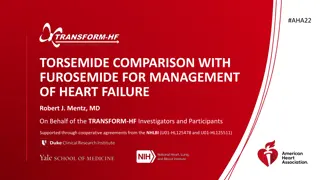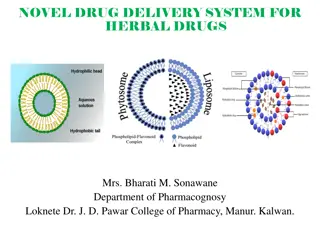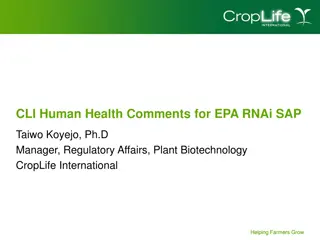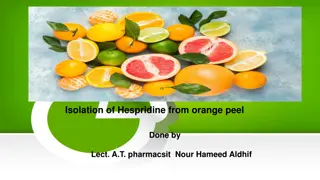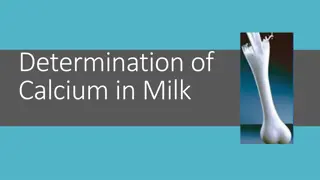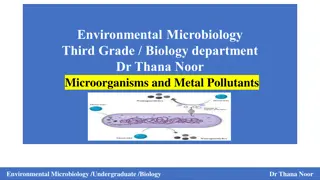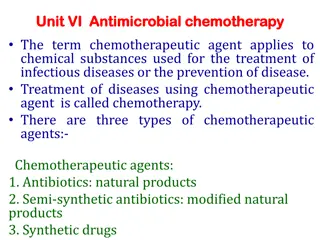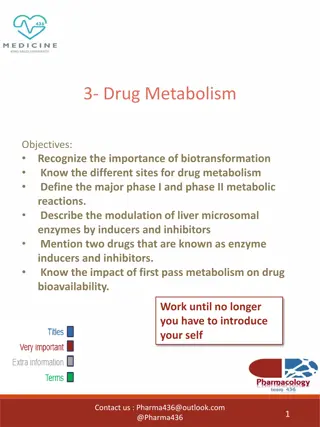OPTHALMIC PREPARATION
Ophthalmic preparations are essential for eye health, and their formulation requires careful consideration of factors like tonicity, pH adjustment, viscosity-imparting agents, stabilizers, antioxidants, surfactants, and preservatives. The goal is to ensure stability, bioavailability, and efficacy wh
1 views • 14 slides
Excipients Market: Integration with Nanotechnology for Targeted Drug Delivery
In 2022, The Global Excipients Market size accounted for USD 5.1 billion. This market is estimated to reach USD 8.9 billion in 2032 at a CAGR of 5.9% between 2023 and 2032.\n\nExcipients Market Overview:\n\nThe excipients market is experiencing robust growth driven by the increasing demand for pharm
3 views • 3 slides
Understanding Nasopulmonary Drug Delivery System
Nasopulmonary drug delivery system, utilizing the nasal route for drug administration, offers advantages such as hepatic first-pass metabolism avoidance and rapid drug absorption. This system is beneficial for pharmacologically active compounds with poor stability in gastrointestinal fluids. While i
0 views • 35 slides
Understanding Drug Absorption Mechanisms in Pharmacy Studies
Drug absorption is a crucial process in pharmacology, involving the movement of drugs from administration sites to systemic circulation. Explore the definitions, bioavailability, routes of administration, and mechanisms like passive diffusion through cell membranes. Gain insights into how drugs disi
0 views • 13 slides
Torsemide vs. Furosemide in Heart Failure Management Study Overview
This study compares the long-term effects of torsemide versus furosemide in the management of heart failure. Torsemide may offer advantages such as more consistent oral bioavailability and longer action duration. The study aims to determine if torsemide reduces mortality by 20% compared to furosemid
0 views • 15 slides
Enhancing Herbal Drug Efficacy: Novel Delivery Systems
In the modern era, herbal drugs offer a safer alternative to synthetic molecules with fewer side effects. However, their efficacy can vary due to fluctuating concentrations of active constituents. Novel Drug Delivery Systems (NDDS) such as liposomes, niosomes, and microspheres play a crucial role in
0 views • 30 slides
Understanding Physicochemical Properties of Drugs
The physicochemical properties of drugs play a crucial role in their pharmacological effects. These properties include physical and chemical characteristics that influence interactions with biomolecules. Solubility, partition coefficient, and dissociation constant are key factors affecting drug beha
1 views • 46 slides
Importance of In-Vitro Dissolution Testing in Drug Assessment
In drug development, in-vitro dissolution testing plays a crucial role in evaluating drug release from tablets when in-vivo bioavailability studies are limited. By ensuring drug release is close to 100% and uniform batch to batch, these tests help assess drug availability and effectiveness. Regulato
11 views • 10 slides
Understanding Drug Absorption, Excretion, and Bioavailability in Humans
Delve into the complex processes of drug absorption, excretion, and bioavailability in the human body. Learn about the various factors affecting drug absorption from the gastrointestinal tract, including biological, physiochemical, and pharmaceutical factors. Explore the mechanisms of drug transport
0 views • 24 slides
Impact of Replacing Inorganic Zinc with Organic Zinc on Buffalo Calves
The study explores the effects of replacing inorganic zinc with a lower level of organic zinc (zinc propionate) on performance, biochemical constituents, and mineral status in buffalo calves. Zinc deficiency is a critical issue affecting growth, immunity, and reproduction in livestock. Inorganic min
0 views • 27 slides
Understanding Soft Gelatin Capsules and Their Advantages
Soft gelatin capsules are one-piece forms enclosing liquid or semi-liquid fill, offering advantages such as improved bioavailability, enhanced drug stability, and easy swallowability. They come with unique features like diverse colors, sizes, and shapes. Despite their benefits, they have limitations
0 views • 28 slides
Understanding Biological Uptake of Trace Elements in Natural Systems
Explore the connection between stoichiometric plasticity and trace metal distribution, investigate microbial acquisition systems, analyze modes of metal uptake, and address co-limitations and interactions within organisms. Utilize molecular tools to enhance knowledge on trace element bioavailability
0 views • 5 slides
Safety and Efficacy of RNA in Human Diet and Agricultural Crops
RNA is a common component of the human diet, with naturally occurring RNAi mechanisms in various organisms. While staple foods contain RNA, barriers in the human body limit systemic exposure, making oral ingestion ineffective for RNAi. Studies have shown minimal bioavailability and efficacy of dieta
0 views • 9 slides
Understanding Folate: Structure, Sources, and Bioavailability
Folate, also known as vitamin B9, plays a crucial role in various bodily functions. Folic acid and folate are different forms of the vitamin, with distinct sources and structures. Good food sources of folate include green vegetables, legumes, fruits, and fortified products. The bioavailability of fo
0 views • 24 slides
Extraction and Detection of Hesperidin from Orange Peel
Hesperidin, a flavonoid found in citrus fruits like orange peel, has various beneficial effects including anti-inflammatory, antioxidant, and anticarcinogenic properties. This article discusses the extraction methods and detection techniques for isolating hesperidin, with an emphasis on its molecula
0 views • 9 slides
Importance of Calcium in Milk for Bone Health
Calcium is a crucial mineral essential for maintaining strong bones and teeth, muscle function, and blood circulation. This article discusses the significance of calcium, recommended daily intakes, sources of calcium in milk, and a complexometric titration method for determining calcium levels. Milk
0 views • 10 slides
The Role of Microorganisms in Mitigating Heavy Metal Pollution
Metal pollution poses health and ecological risks globally, with heavy metals like mercury and lead causing various harmful conditions. Microorganisms play a crucial role in altering the bioavailability and toxicity of metals. By converting elemental mercury to methylmercury and affecting the valenc
0 views • 9 slides
Understanding Antimicrobial Chemotherapy Agents
Chemotherapeutic agents, including antibiotics, semi-synthetic antibiotics, and synthetic drugs, are used to treat infectious diseases. These agents should possess ideal characteristics such as selectiveness, broad antimicrobial spectrum, no side effects, and suitable bioavailability to be effective
0 views • 30 slides
Understanding Drug Metabolism: Importance and Mechanisms
Drug metabolism is a crucial process in the body that transforms drugs into forms easily excreted, affecting their efficacy and toxicity. This involves different sites such as the liver, kidney, and plasma, with enzymes in cellular organelles like cytoplasm and mitochondria playing key roles. First-
0 views • 13 slides
